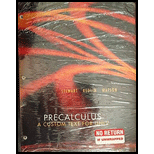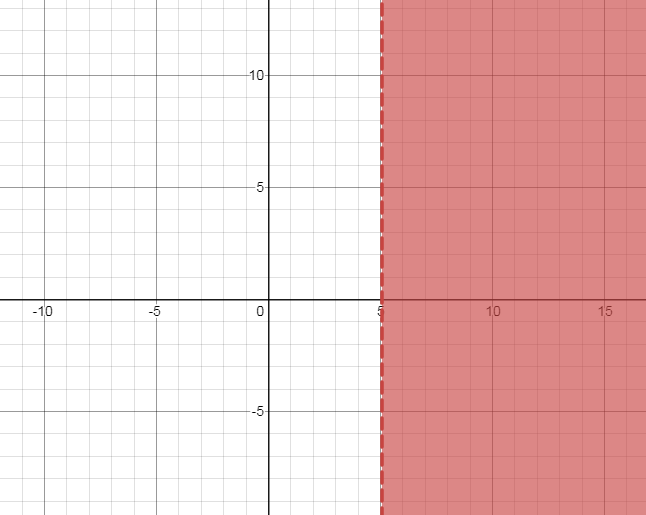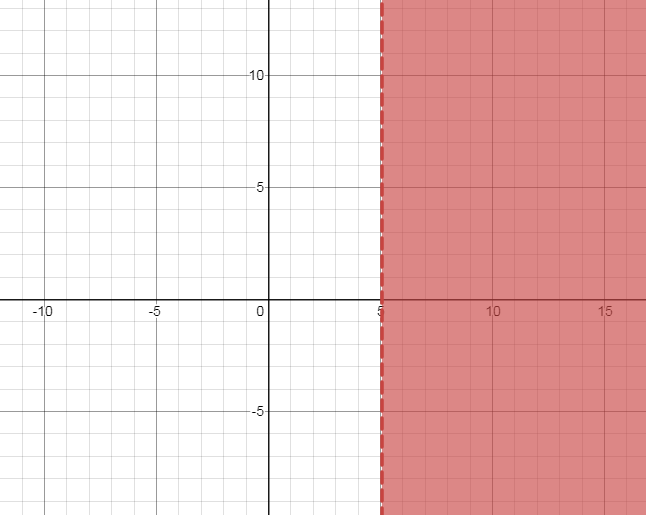
Concept explainers
To calculate: The solution of the given inequality and express the solution using interval notation. Also graph the solution set on the real number line.
Answer to Problem 98RE
The shaded region shows solution of the given inequality on the graph below .

Explanation of Solution
Given information:
The given inequality is
Formula used:
In order to solve an inequality, the following things can be done.
• Add the same quantity to each side of th inequality
• Subtract the same quantity from each side
• Multiply or divide each side by the same positive quantity and If multiplied or divided each side by a negative quantity, then the inequality symbol must be reversed.
In case of non linear inequality,the function may be factorised and solved further long division method etc.
Calculation:
In order to solve an inequality, the following things can be done.
• Add the same quantity to each side of th inequality
• Subtract the same quantity from each side
• Multiply or divide each side by the same positive quantity and If multiplied or divided each side by a negative quantity, then the inequality symbol must be reversed.
The inequality can be solved as follows:
The solution using interval notation is
The marked line shows the given inequality on the graph below .
Calculation:
In order to solve an inequality, the following things can be done.
• Add the same quantity to each side of th inequality
• Subtract the same quantity from each side
• Multiply or divide each side by the same positive quantity and If multiplied or divided each side by a negative quantity, then the inequality symbol must be reversed.
The inequality can be solved as follows:
The interval notation is
The marked line shows the given inequality on the graph below .
 ..
..
Chapter 1 Solutions
Precalculus - A Custom Text for UNLV
- Consider the Boundary-Initial Value problem J²u и ди 4 0 0 მე2 It u(0,t) = 0, 0, u(6,t) = 0, t>0 u(x, 0) = x(6x), 0 < x <6 This models a heated wire, with zero endpoints temperatures. The solution u(x,t) of the initial-boundary value problem is given by the series u(x,t)-b, sin П3 n=1 (b, sin ((2n − 1) — x) e-cnt where bn ☐ and Сп ☐arrow_forward• -7 10 1.0 (2 - x) for 0 < x < 2, Let f(x) = for 2< x < 6. Compute the Fourier cosine coefficients for f(x). Ao An Give values for the Fourier cosine series C(x) = = Ao • C(6) = = C(-1) = = C(11) = + n=1 IM 8 An cos пп (π x ). 6arrow_forwardThe Fourier series of the function is given by where со Сп and bn || f(x) = {- 9x if π < x < 0 -4x if 0 < x < π f(x) ~ CO n=0 (Cn cos ((2n+1) x) - Σ bn sin (nx) n=1arrow_forward
- Consider the Boundary-Initial Value problem a²u J²u 9 მე2 Ət²' , 0 0 u(0,t) = 0, u(5,t) = 0, ди u(x, 0) = x(5 − x), at t>0 (x, 0) = 0, 0 < x < 5 This models the displacement u(x,t) of a freely vibrating string, with fixed ends, initial profile x (5 - x), and zero initial velocity. The solution u(x, t), is given by the series ∞ 4 u(x, t) = n=1 bɲ sin (· П (n = 7 x ) cos(cnt) where ཆུ་ང་ and Сп =arrow_forwardThe Fourier sine series of the function is given by 3x f(x) = = if 0x5/3 5 if 5/3 x < 5 where bn b₁ = ☐ ∞ ƒ(2) ~ Σb, sin (n = 2) n=1 (품)arrow_forwardFind the values of a and b for which each function will be differentiable for all values of x on its domain. Note: Please write the answer in the form of ordered pairs (a, b). a² f(x) = x -2b, x ≤-1 b²x,x > −1 2ax²+62arrow_forward
- k. 1. |_ 1/2 S 0 cos(x-2) x3 √1+ e¯x ex dx dxarrow_forwardAttempt 6: 1 out of 2 parts have been answered correctly. Calculate the Taylor polynomials T2(x) and T3(x) centered at x = 7 for f(x) = ln(x + 1). T₂(x) T-(2) - in (8) - (½) (x-7) - (128)(x-7)2 8 Tз(x) = 2(x)+ In(8) + ½ ½ (x-7) - 128 (x-7)² + 1536 (x-7)3 8 Try again Next item Answers Attempt 6 of 6 Ei T The Weather Channel DELL UP % 8 9 205 54 # m E R D F G Harrow_forwardQuestion 3 1 pts By changing to spherical coordinates, calculate A = SSS, e(x²+y²+z²)³/2/2 dV, = 2x and y = where D is the region in the first octant between the planes y = above the cone z = /3(x² + y²), and between the spheres x² + y² + z² and x² + y² + z² = 4. Then sin(4A) is 3x, = 1 0.442 -0.438 -0.913 0.143 -0.502 -0.574 0.596 -0.444arrow_forward
- 2.10 Related rares show me all the correc steps and calculation please DO NOT GIVE ME THE WROTE ANSWER A stone is dropped into a pond, forming a circular wave whose radius is increasing at a rate of 3 inches per second. When the radius is 9 inches, at what rate is the area of the wave growing?arrow_forward2.10 Related rares show me all the correc steps and calculation please DO NOT GIVE ME THE WROTE ANSWER A rectangular screen saver is set up so that its length is always one centimeter more than its height. If the length is increasing at a rate of 2 centimeters per second, at what rate is the area growing when its height is 7 centimeters?arrow_forwardSolve: coshx-1.dx do Sinho + cosho Solve: S Salve dx 4-x2 Solve dx √ex+1 If y = (x² +1). sech (lax), fnd dry. If y = /R/cschx + cothx|, 2nd dyarrow_forward
 Calculus: Early TranscendentalsCalculusISBN:9781285741550Author:James StewartPublisher:Cengage Learning
Calculus: Early TranscendentalsCalculusISBN:9781285741550Author:James StewartPublisher:Cengage Learning Thomas' Calculus (14th Edition)CalculusISBN:9780134438986Author:Joel R. Hass, Christopher E. Heil, Maurice D. WeirPublisher:PEARSON
Thomas' Calculus (14th Edition)CalculusISBN:9780134438986Author:Joel R. Hass, Christopher E. Heil, Maurice D. WeirPublisher:PEARSON Calculus: Early Transcendentals (3rd Edition)CalculusISBN:9780134763644Author:William L. Briggs, Lyle Cochran, Bernard Gillett, Eric SchulzPublisher:PEARSON
Calculus: Early Transcendentals (3rd Edition)CalculusISBN:9780134763644Author:William L. Briggs, Lyle Cochran, Bernard Gillett, Eric SchulzPublisher:PEARSON Calculus: Early TranscendentalsCalculusISBN:9781319050740Author:Jon Rogawski, Colin Adams, Robert FranzosaPublisher:W. H. Freeman
Calculus: Early TranscendentalsCalculusISBN:9781319050740Author:Jon Rogawski, Colin Adams, Robert FranzosaPublisher:W. H. Freeman
 Calculus: Early Transcendental FunctionsCalculusISBN:9781337552516Author:Ron Larson, Bruce H. EdwardsPublisher:Cengage Learning
Calculus: Early Transcendental FunctionsCalculusISBN:9781337552516Author:Ron Larson, Bruce H. EdwardsPublisher:Cengage Learning





